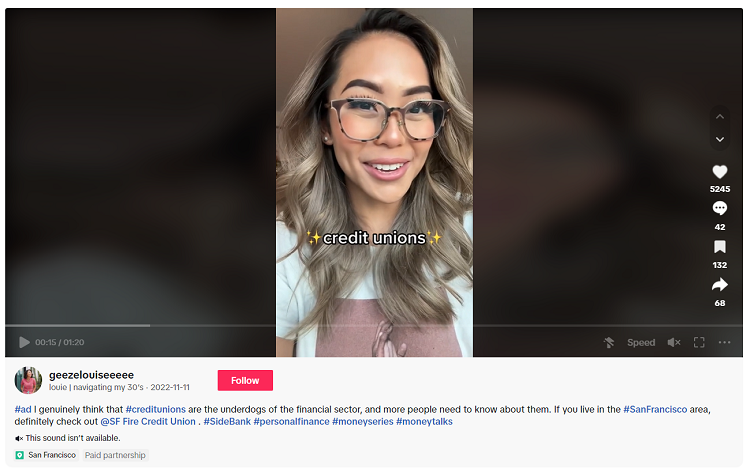Top-Level Takeaways
- Influencer Partnerships: SF Fire Credit Union uses local social media influencers to engage with a younger audience, significantly boosting brand awareness and product promotion.
- Targeted And Measurable Campaigns: The credit union emphasizes the importance of targeting specific demographics and regularly measuring campaign performance to make the most of outreach and engagement.
- Compliance And Flexibility: Ensuring influencer content complies with marketing and legal standards while allowing influencers creative freedom is crucial for maintaining authenticity and trust.

Credit unions have an ongoing challenge connecting with the next generation of members, and it shows. According to the World Council of Credit Unions, the average age of a North American credit union member is 53.
Attracting younger members is critical for the long-term sustainability of all cooperatives, and many credit unions are looking online to do so. That might be a smart strategy, as Generation Z is almost five times more likely to get financial advice from social media platforms than people 41 or older, according to the World Economic Forum. Accordingly, “finfluencers” — influencers who provide financial advice — are on the rise.
Online communities are rife with financial misinformation. Credit unions can help members — especially younger ones — sort the good intelligence from the bad. Learn more in “Help Members Make Sense Of Social Media Mayhem.”
Although most credit unions are active on some social media channels, partnerships with the influencers younger people know, follow, and trust are still rare.
“It’s like ships passing in the night,” says Josephine Chew, chief marketing officer for SF Fire Credit Union ($1.8B, San Francisco, CA). “Many traditional financial advisors are posting on LinkedIn and Facebook, but the Gen Z audience is getting their advice from sources like TikTok, YouTube, and Reddit. Even if TikTok is banned in a year, our audience is there right now and we should be, too.”
That’s why the Bay Area cooperative has established partnerships with local influencers — ones who already have a strong Gen Z audience that trusts them — to raise brand awareness and promote products.
The selected content creators are helping SF Fire reach young people in the Bay Area where they want to be reached and engage them how they want to be engaged. That could be a smart move — one of SF Fire’s sponsored brand-building TikTok posts went viral, gaining 1.6 million views, reaching well beyond the influencer’s primary followers, and far exceeding the credit union’s goals.
“Getting 1.6 million organic views was a big win for us,” Chew says.

#GoodFitPartnerships
Identifying the right influencer requires knowing what the audience wants. Chew, who has been involved in influencer marketing for nearly a decade and in the credit union industry for the past two years, has used both agencies and platforms to vet potential partners.
SF Fire currently uses the popular platform Influential.co to connect with many influencers at the same time and help it evaluate their content. The platform allows users to see whether influencer content warrants a G, PG, or more explicit rating. It also allows users to determine if the influencer has previously worked for competitors, which could detract from the trust they’ve built with their audience and water down the cooperative’s message.
@baxate_carterStart earning on your savings, check out SF Fire Credit Union! @SF Fire Credit Union, #Banking #FinancialPlanning♬ original sound – Baxate
“I put together a marketing brief and influencers can bid on it through the platform, which acts as a middleman,” Chew says. “It’s basically an RFP process that includes all the sourcing and contract negotiations.”
Once the credit union receives bids, it can review the profiles of each influencer and learn more about their focus — for example, lifestyle, financial, healthcare, or something else — and audience.
“This takes some of the personal bias out of the process,” Chew says. “I don’t want to choose someone just because I think they are the right fit. I want to see who is following them and ensure it matches our specific target audience, like women 18 to 30.”
#BiggerPicture
There is a lot of science behind forging an influencer partnership, and the process can be surprisingly technical. But, Chew says luck plays a role, too.

“You might know what the trends are, but you never really know what will work,” the chief marketer advises. “What performs well on one platform might not perform on another. Sometimes, you just have to put it out there and see what sticks.”
This is one of the reasons influencer partnerships are but one part of a multi-pronged, integrated marketing campaign strategy at SF Fire. As part of that larger plan, influencer content requires a compliance review and approval before posting.
“For influencers, this is often their livelihood,” Chew says. “They want to protect their brand, too, and our review and approval process ensures content is in compliance with all marketing rules, copyright usage, image usage, and FCC rules that identify it as sponsored.”
It also requires regular tracking and reporting on the results.
Chew, who is a digital marketer by trade, insists on measurable campaigns. For awareness campaigns, SF Fire looks at engagement statistics such as completed views and-click throughs. For product campaigns — such as the one SF Fire ran for a 5% certificate — the team tracks the number of applications started and applications completed.
#BestPractices #SageAdvice
Early in its influencer efforts, SF Fire ran market tests to evaluate whether financial or lifestyle content creators would be more effective. It also assessed whether creators with a large, national following would be better than locally focused ones. Ultimately, it determined lifestyle influencers in the San Franciso Bay Area were better at connecting with the credit union’s intended target audience.
CU QUICK FACTS
SF FIRE CREDIT UNION
DATA AS OF 03.31.24
HQ: San Francisco, CA
ASSETS: $1.7B
MEMBERS: 78,801
BRANCHES: 3
EMPLOYEES: 175
NET WORTH: 8.8%
ROA: 0.49%
The cooperative plans to continue partnering with some of the influencers whose content has performed well in the past and has extended contract periods and re-used content as paid advertising on different platforms like YouTube or television. It also insists on a three-month non-compete clause and is continually testing new opportunities with other influencers.
“Even if a certain content creator worked well for one type of campaign, they might not work well for another,” Chew says.
It can be difficult for credit union marketers to resist the temptation to tweak a campaign for wider accessibility, but Chew says it’s best to loosen the reins and allow influencers the flexibility and autonomy to create content that’s true to their brand.
“Don’t direct your influencer too much,” she says. “People watch them because of the brand and following they’ve built.”
With only a few large banks like Wells Fargo and Chase active in the space, influencer marketing is wide open for financial institutions. But sometimes internal hurdles are just as difficult to surmount as external competition. To alleviate security concerns often raised by CEOs, CIOs, and CTOs, Chew advises having an open discussion about how to safely use the tools and personalities while managing risk.
“If credit union marketers are blocked from using tools like TikTok, then half of the young people the industry is trying to reach are not seeing the credit union message,” Chew says. “As marketers, we need to be where our audience is.”
Want more on microinfluencer strategies? Read “5 Lessons For Mega Success With Microinfluencers.”